Comparative Proteomic Analysis of an Ethyl Tert-Butyl Ether-Degrading Bacterial Consortium
Abstract
:1. Introduction
2. Materials and Methods
2.1. Enrichment of the Bacterial Consortium
2.2. Isolation and Identification of the Bacterial Strains
2.3. Biodegradation Experiments
2.4. Proteomic Analysis
3. Results and Discussion
3.1. Biodegradation Using Consortium B
3.2. Comparative Metaproteomic Analysis of the ETBE-Degrading Consortium
Identification of the Protein Spots
4. Conclusions
Supplementary Materials
Author Contributions
Funding
Institutional Review Board Statement
Acknowledgments
Conflicts of Interest
References
- Barceló, D.; Arvin, E. Fuel Oxygenates; Springer: Berlin/Heidelberg, Germany, 2007. [Google Scholar]
- Kian, F.Y.; Abdul, R.M.; Soon, H.T. A review on the evolution of ethyl tert-butyl ether (ETBE) and its future prospects. Renew. Sustain. Energy Rev. 2013, 22, 604–620. [Google Scholar]
- Squillace, P.J.; Zogorski, J.S.; Wilber, W.G.; Price, C.V. Preliminary Assessment of the Occurrence and Possible Sources of MTBE in Groundwater in the United States. 1993−1994. Environ. Sci. Technol. 1996, 30, 1721–1730. [Google Scholar] [CrossRef]
- Schmidt, T.C.; Schirmer, M.; Weiß, H.; Haderlein, S.B. Microbial degradation of methyl tert-butyl ether and tert-butyl alcohol in the subsurface. J. Contam. Hydrol. 2004, 70, 173–203. [Google Scholar] [CrossRef] [PubMed]
- Rosell, M.; Barceló, D.; Rohwerder, T.; Breuer, U.; Gehre, M.; Richnow, H.H. Variations in 13C/12C and D/H Enrichment Factors of Aerobic Bacterial Fuel Oxygenate Degradation. Environ. Sci. Technol. 2007, 41, 2036–2043. [Google Scholar] [CrossRef] [PubMed]
- Zereshki, S.; Figoli, V.; Madaeni, S.S.; Galiano, F.; Drioli, E. Pervaporation separation of ethanol/ETBE mixture using poly(lactic acid)/poly(vinyl pyrrolidone) blend membranes. J. Membr. Sci. 2011, 373, 29–35. [Google Scholar] [CrossRef]
- Malandain, C.; Fayolle-Guichard, F.; Vogel, T.M. Cytochromes P450-mediated degradation of fuel oxygenates by environmental isolates. FEMS Microbiol. Ecol. 2010, 72, 289–296. [Google Scholar] [CrossRef] [Green Version]
- Auffret, M.; Yergeau, E.; Labbé, V.; Fayolle-Guichard, F.; Greer, C. Importance of Rhodococcus strains in a bacterial consortium degrading a mixture of hydrocarbons, gasoline, and diesel oil additives revealed by metatranscriptomic analysis. Appl. Microbiol. Biotechnol. 2015, 99, 2419–2430. [Google Scholar] [CrossRef]
- Balseiro-Romero, M.; Macías, F.; Monterroso, C. Characterization and fingerprinting of soil and groundwater contamination sources around a fuel distribution station in Galicia (NW Spain). Environ. Monit. Assess. 2016, 188, 292. [Google Scholar] [CrossRef]
- Fayolle-Guichard, F.; Durand, J.; Cheucle, M.; Rosell, M.; Michelland, R.J.; Tracol, J.-P.; Le Roux, F.; Grundman, G.; Atteia, O.; Richnow, H.H.; et al. Study of an aquifer contaminated by ethyl tert-butyl ether (ETBE): Site characterization and on-site bioremediation. J. Hazard. Mater. 2012, 201–202, 236–243. [Google Scholar] [CrossRef]
- Digabel, Y.L.; Demanèche, S.; Benoit, Y.; Vogel, T.; Fayolle-Guichard, F. Ethyl tert-butyl ether (ETBE) biodegradation by a syntrophic association of Rhodococcus sp. IFP 2042 and Bradyrhizobium sp. IFP 2049 isolated from a polluted aquifer. Appl. Microbiol. Biotechnol. 2013, 97, 10531–10539. [Google Scholar] [CrossRef]
- Inal, F.; Yetgin, S.; Aksu, G.; Simsek, S.; Sofuoglu, A.; Sofuoglu, S. Activated Carbon Adsorption of Fuel Oxygenates MTBE and ETBE from Water. Water Air Soil Pollut. 2009, 204, 155–163. [Google Scholar] [CrossRef]
- van Wezel, A.; Puijker, L.; Vink, C.; Versteegh, A.; de Voogt, P. Odour and flavour thresholds of gasoline additives (MTBE, ETBE and TAME) and their occurrence in Dutch drinking water collection areas. Chemosphere 2009, 76, 672–676. [Google Scholar] [CrossRef] [PubMed] [Green Version]
- Croezen, H.; Kampman, B. The impact of ethanol and ETBE blending on refinery operations and GHG-emissions. Energ Policy 2009, 37, 5226–5238. [Google Scholar] [CrossRef]
- McGregor, D. Ethyl tertiary-Butyl Ether: A Toxicological Review. Crit. Rev. Toxicol. 2007, 37, 287–312. [Google Scholar] [CrossRef]
- Saito, A.; Sasaki, T.; Kasai, T.; Katagiri, T.; Nishizawa, V.; Noguchi, T.; Aiso, S.; Nagano, S.; Fukushima, K. Hepatotumorigenicity of ethyl tertiary-butyl ether with 2-year inhalation exposure in F344 rats. Arch. Toxicol. 2013, 87, 905–914. [Google Scholar] [CrossRef]
- Salazar, K.D.; Brinkerhoff, C.J.; Lee, J.S.; Chiu, W.A. Development and application of a rat PBPK model to elucidate kidney and liver effects induced by ETBE and tert-butanol. Toxicol. Appl. Pharm. 2015, 288, 439–452. [Google Scholar] [CrossRef]
- Weng, Z.; Ohtani, K.; Suda, M.; Yanagiba, Y.; Kawamoto, T.; Nakajima, T.; Wang, R.-S. Assessment of the reproductive toxicity of inhalation exposure to ethyl tertiary butyl ether in male mice with normal, low active and inactive ALDH2. Arch. Toxicol. 2014, 88, 1007–1021. [Google Scholar] [CrossRef]
- Gunasekaran, V.; Stam, L.; Constantí, M. The effect of BTX compounds on the biodegradation of ETBE by an ETBE degrading bacterial consortium. Biotechnol. Bioproces 2013, 18, 1216–1223. [Google Scholar] [CrossRef]
- Hernandez-Perez, G.; Fayolle, F.; Vandecasteele, J.-P. Biodegradation of ethyl t-butyl ether (ETBE), methyl t-butyl ether (MTBE) and t-amyl methyl ether (TAME) by Gordonia terrae. Appl. Microbiol. Biotechnol. 2001, 55, 117–121. [Google Scholar] [CrossRef]
- Lechner, U.; Brodkorb, D.; Geyer, R.; Hause, G.; Härtig, C.; Auling, G.; Fayolle-Guichard, F.; Piveteau, P.; Müller, R.H.; Rohwerder, T. Aquincola tertiaricarbonis gen. nov., sp. nov., a tertiary butyl moiety-degrading bacterium. Int. J. Syst. Evol. Microbiol. 2007, 57, 1295–1303. [Google Scholar] [CrossRef] [Green Version]
- Auffret, M.; Labbé, D.; Thouand, G.; Greer, C.W.; Fayolle-Guichard, F. Degradation of a Mixture of Hydrocarbons, Gasoline, and Diesel Oil Additives by Rhodococcus aetherivorans and Rhodococcus wratislaviensis. Appl. Environ. Microb. 2009, 75, 7774–7782. [Google Scholar] [CrossRef]
- Speda, J.; Jonsson, B.-H.; Carlsson, U.; Karlsson, M. Metaproteomics-guided selection of targeted enzymes for bioprospecting of mixed microbial communities. Biotechnol. Biofuels 2017, 10, 128. [Google Scholar] [CrossRef] [Green Version]
- Arsène-Ploetze, F.; Bertin, P.N.; Carapito, C. Proteomic tools to decipher microbial community structure and functioning. Environ. Sci. Pollut. Res. 2015, 22, 13599–13612. [Google Scholar] [CrossRef] [PubMed] [Green Version]
- Xu, G.; Greene, G.H.; Yoo, H.; Liu, L.; Marqués, J.; Motley, J.; Dong, X. Global translational reprogramming is a fundamental layer of immune regulation in plants. Nature 2017, 545, 22371. [Google Scholar] [CrossRef] [PubMed]
- Okeke, B.C.; Frankenberger, W.T. Biodegradation of methyl tertiary butyl ether (MTBE) by a bacterial enrichment consortia and its monoculture isolates. Microbiol. Res. 2003, 158, 99–106. [Google Scholar] [CrossRef]
- Kern, E.A.; Veeh, R.H.; Langner, H.W.; Macur, R.E.; Cunningham, A.B. Characterization of Methyl tert-Butyl Ether-Degrading Bacteria from a Gasoline-Contaminated Aquifer. Bioremediat. J. 2002, 6, 113–124. [Google Scholar] [CrossRef]
- Beal, R.; Betts, W.B. Role of rhamnolipid biosurfactants in the uptake and mineralization of hexadecane in Pseudomonas aeruginosa. J. Appl. Microbiol. 2000, 89, 158–168. [Google Scholar] [CrossRef]
- Pornsunthorntawee, O.; Wongpanit, P.; Chavadej, S.; Abe, M.; Rujiravanit, R. Structural and physicochemical characterization of crude biosurfactant produced by Pseudomonas aeruginosa SP4 isolated from petroleum-contaminated soil. Bioresour. Technol. 2008, 99, 1589–1595. [Google Scholar] [CrossRef] [PubMed]
- You, Y.; Shim, J.; Cho, C.-H.; Ryu, M.-H.; Shea, P.J.; Kamala-Kannan, S.; Chae, J.-C.; Oh, B.-T. Biodegradation of BTEX mixture by Pseudomonas putida YNS1 isolated from oil-contaminated soil. J. Basic Microb. 2013, 53, 469–475. [Google Scholar] [CrossRef]
- Ma, J.; Xu, V.; Jia, L. Characterization of pyrene degradation by Pseudomonas sp. strain Jpyr-1 isolated from active sewage sludge. Bioresour. Technol. 2013, 140, 15–21. [Google Scholar] [CrossRef]
- Tanti, B.; Buragohain, A.K. Biodegradation of petroleum tar by Pseudomonas Spp. from oil field of Assam, India. Bioremediat. J. 2013, 17, 107–112. [Google Scholar] [CrossRef]
- Li, G.H.; Zhang, X.; Huang, V. Enhanced biodegradation of petroleum hydrocarbons in polluted soil. J. Environ. Sci. Health A 2000, 35, 177–188. [Google Scholar] [CrossRef]
- Su, J.J.; Kafkewitz, D. Toluene and xylene degradation by a denitrifying strain of Xanthomonas maltophilia with limited or no oxygen. Chemosphere 1996, 32, 1843–1850. [Google Scholar] [CrossRef]
- Manickam, N.; Misra, V.; Mayilraj, S. A novel pathway for the biodegradation of γ-hexachlorocyclohexane by a Xanthomonas sp. strain ICH12. J. Appl. Microbiol. 2007, 102, 1468–1478. [Google Scholar] [CrossRef]
- Herrera-González, V.; Ruiz-Ordaz, N.; Galíndez-Mayer, J.; Juárez-Ramírez, C.; Santoyo-Tepole, F.; Montiel, E. Biodegradation of the herbicide propanil, and its 3,4-dichloroaniline by-product in a continuously operated biofilm reactor. World J. Microb. Biotechnol. 2013, 29, 467–474. [Google Scholar] [CrossRef] [PubMed]
- Liu, C.Y.; Speitel, G.E.; Georgiou, G. Kinetics of methyl t-buthyl ether cometabolism at low concentrations by pure cultures of butane-degrading bacteria. Appl. Environ. Microb. 2001, 67, 2197–2201. [Google Scholar] [CrossRef] [PubMed] [Green Version]
- Im, W.-T.; Bae, H.-S.; Yokota, A.; Lee, S.T. Herbaspirillum chlorophenolicum sp. nov., a 4-chlorophenol-degrading bacterium. Int. J. Syst. Evol. Microbiol. 2004, 54, 851–855. [Google Scholar] [CrossRef] [Green Version]
- Xu, H.; Wu, H.; Qiu, Y.; Shi, X.; He, G.; Zhang, J.; Wu, J. Degradation of fluoranthene by a newly isolated strain of Herbaspirillum chlorophenolicum from activated sludge. Biodegradation 2011, 22, 335–345. [Google Scholar] [CrossRef]
- Wang, Y.; Wan, R.; Zhang, S.; Xie, S. Anthracene biodegradation under nitrate-reducing condition and associated microbial community changes. Biotechnol. Bioprocess Eng. 2012, 17, 371–376. [Google Scholar] [CrossRef]
- Kyselkova, M.; Salles, J.F.; Dumestre, A.; Benoit, Y.; Grundmann, G.L. Distinct bacterial consortia established in ETBE-degrading enrichments from a polluted aquifer. Appl. Sci. 2019, 9, 4247. [Google Scholar] [CrossRef] [Green Version]
- Nicholls, H.C.G.; Mallinson, H.E.H.; Rolfe, S.A.; Hjort, M.; Spence, M.J.; Thornton, S.F. Influence of contaminant exposure on the development of aerobic ETBE biodegradation potential in microbial communities from a gasoline-impacted aquifer. J. Hazard. Mater. 2020, 388, 122022. [Google Scholar] [CrossRef]
- Nicholls, H.C.G.; Rolfe, S.A.; Mallinson, H.E.H.; Hjort, M.; Spence, M.J.; Bonte, M.; Thornton, S.F. Distribution of ETBE-degrading microorganisms and functional capability in groundwater, and implications for characterising aquifer ETBE biodegradation potential. Environ. Sci. Pollut. Res. 2022, 29, 1223–1238. [Google Scholar] [CrossRef] [PubMed]
- Williams, M.A.; Taylor, E.B.; Mula, H.P. Metaproteomic characterization of a soil microbial community following carbon amendment. Soil Biol. Biochem. 2010, 42, 1148–1156. [Google Scholar] [CrossRef]
- Wang, D.-Z.; Kong, L.-F.; Li, Y.-Y.; Xie, Z.-X. Environmental Microbial Community Proteomics: Status, Challenges and Perspectives. Int. J. Mol. Sci. 2016, 17, 1275. [Google Scholar] [CrossRef] [Green Version]
- Ferreira, N.L.; Labbé, D.; Monot, F.; Fayolle-Guichard, F.; Greer, C.W. Genes involved in the methyl tert-butyl ether (MTBE) metabolic pathway of Mycobacterium austroafricanum IFP 2012. Microbiology 2006, 152, 1361–1374. [Google Scholar] [CrossRef] [Green Version]
- Hristova, K.R.; Schmidt, R.; Chakicherla, A.Y.; Legler, T.C.; Wu, J.; Chain, P.S.; Scow, K.M.; Kane, S.R. Comparative Transcriptome Analysis of Methylibium petroleiphilum PM1 Exposed to the Fuel Oxygenates Methyl tert-Butyl Ether and Ethanol. Appl. Environ. Microb. 2007, 73, 7347–7357. [Google Scholar] [CrossRef] [PubMed] [Green Version]
- Rohwerder, T.; Breuer, U.; Benndorf, D.; Lechner, U.; Müller, R.H. The Alkyl tert-Butyl Ether Intermediate 2-Hydroxyisobutyrate Is Degraded via a Novel Cobalamin-Dependent Mutase Pathway. Appl. Environ. Microb. 2006, 72, 4128–4135. [Google Scholar] [CrossRef] [PubMed] [Green Version]
- Sabirova, J.S.; Ferrer, M.; Regenhardt, D.; Timmis, K.N.; Golyshin, P.N. Proteomic Insights into Metabolic Adaptations in Alcanivorax borkumensis Induced by Alkane Utilization. J. Bacteriol. 2006, 188, 3763–3773. [Google Scholar] [CrossRef] [PubMed] [Green Version]
- Gonzales-Siles, L.; Karlsson, R.; Kenny, D.; Karlsson, A.; Sjöling, A. Proteomic analysis of enterotoxigenic Escherichia coli (ETEC) in neutral and alkaline conditions. BMC Microbiol. 2017, 17, 11. [Google Scholar] [CrossRef] [Green Version]
- Alix, J.-H. The Work of Chaperones. In Protein Synthesis and Ribosome Structure; Wiley-VCH Verlag GmbH & Co., KGaA: Hoboken, NJ, USA, 2006; pp. 529–562. [Google Scholar]
- Eixarch, H.; Constantí, M. Biodegradation of MTBE by Achromobacter xylosoxidans MCM1/1 induces synthesis of proteins that may be related to cell survival. Process Biochem. 2010, 45, 794–798. [Google Scholar] [CrossRef]
- Kucharzyk, K.; Rectanus, H.V.; Bartling, C.M.; Rosansky, S.; Minard-Smith, A.; Mullins, L.A.; Neil, K. Use of omic tools to assess methyl tert-butyl ether (MTBE) degradation in groundwater. J. Hazard. Mater. 2019, 378, 120618. [Google Scholar] [CrossRef] [PubMed]
- Heyer, R.; Kohrs, F.; Reichl, U.; Benndorf, D. Metaproteomics of complex microbial communities in biogas plants. Microbial Biotechnol. 2015, 8, 749–763. [Google Scholar] [CrossRef] [PubMed]
 Control;
Control;  B consortium-EB3;
B consortium-EB3;  bacterial growth (OD at 600 nm). The error bars represent the standard deviation between the replicates (n = 2).
bacterial growth (OD at 600 nm). The error bars represent the standard deviation between the replicates (n = 2).
 Control;
Control;  B consortium-EB3;
B consortium-EB3;  bacterial growth (OD at 600 nm). The error bars represent the standard deviation between the replicates (n = 2).
bacterial growth (OD at 600 nm). The error bars represent the standard deviation between the replicates (n = 2).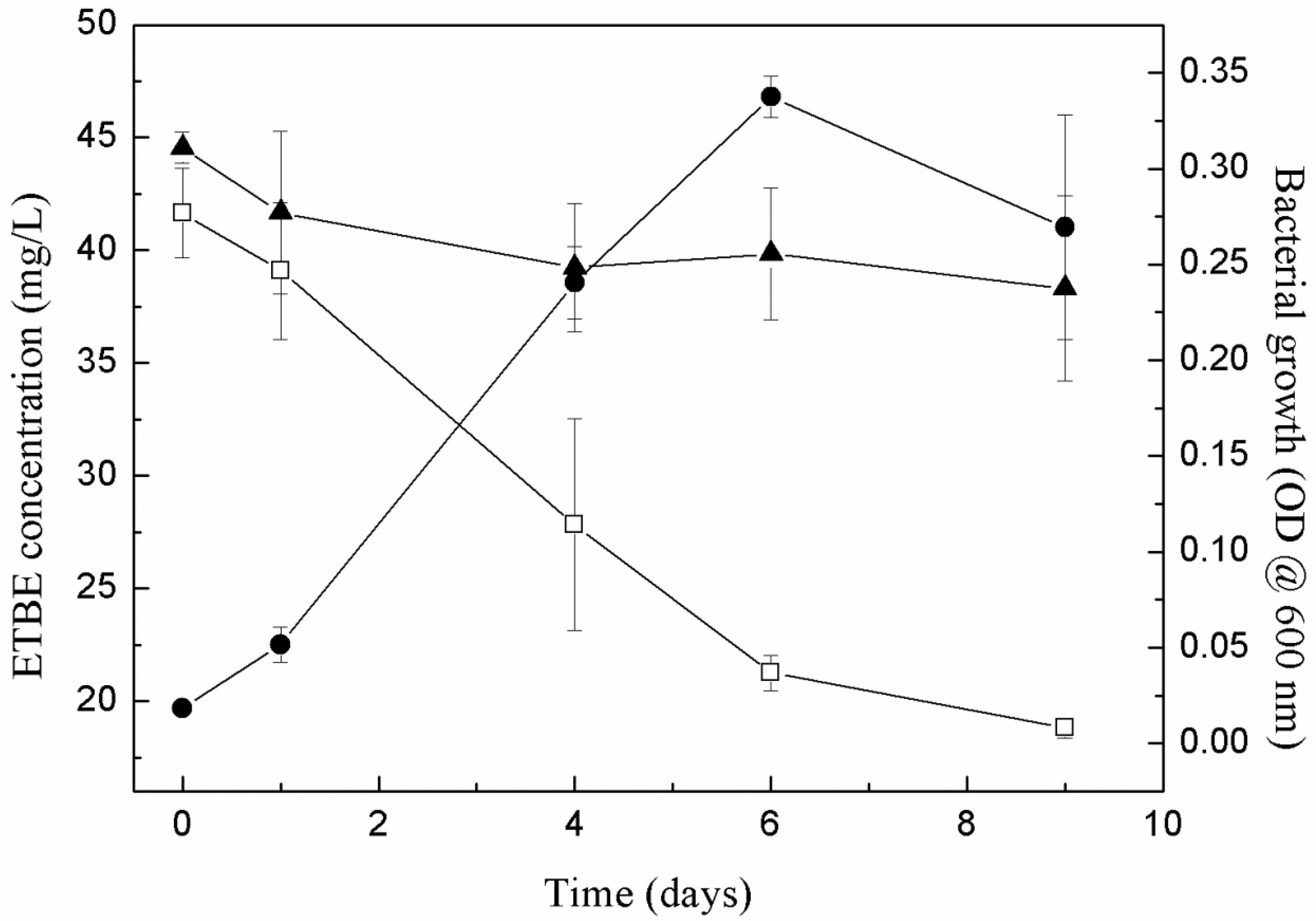
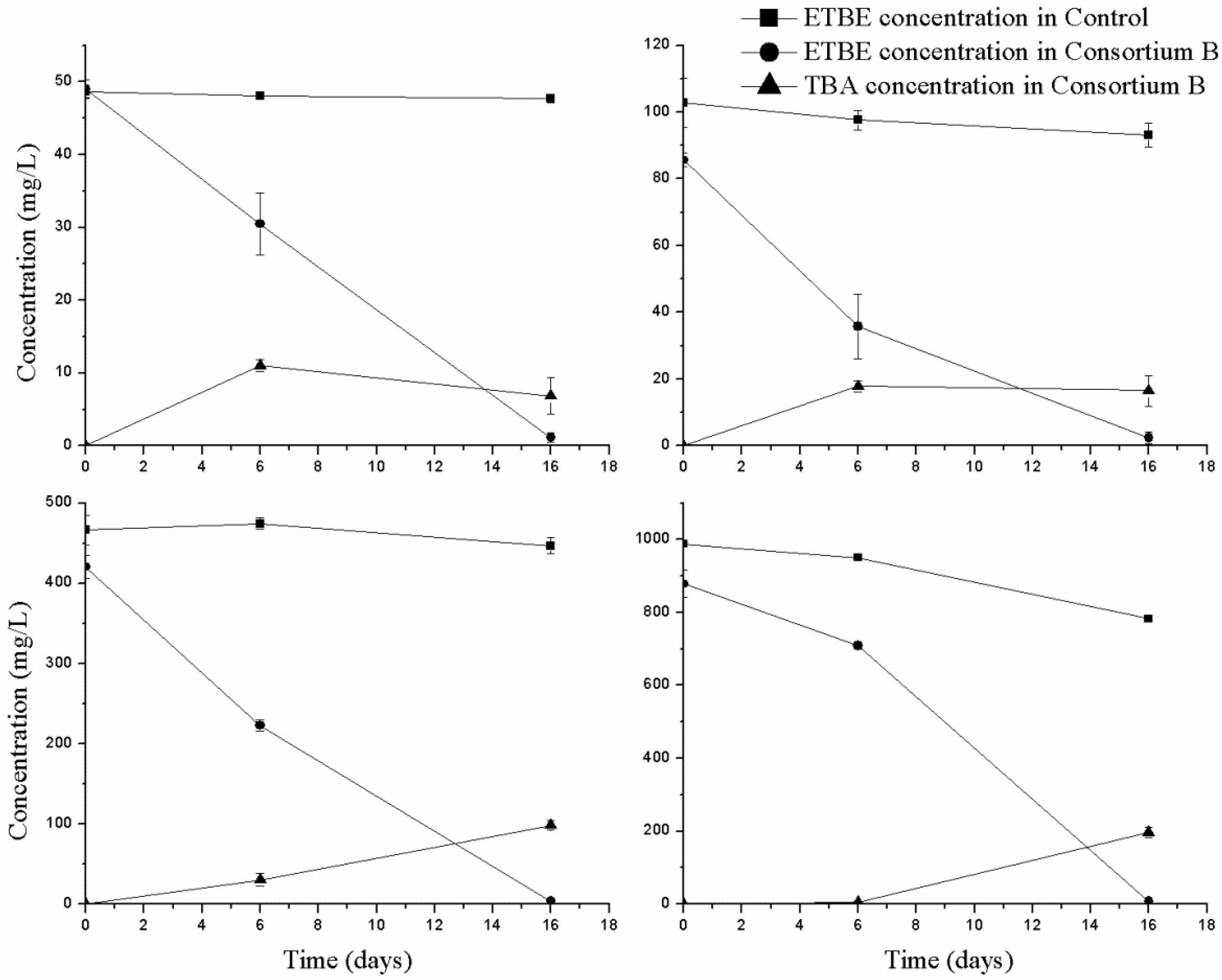
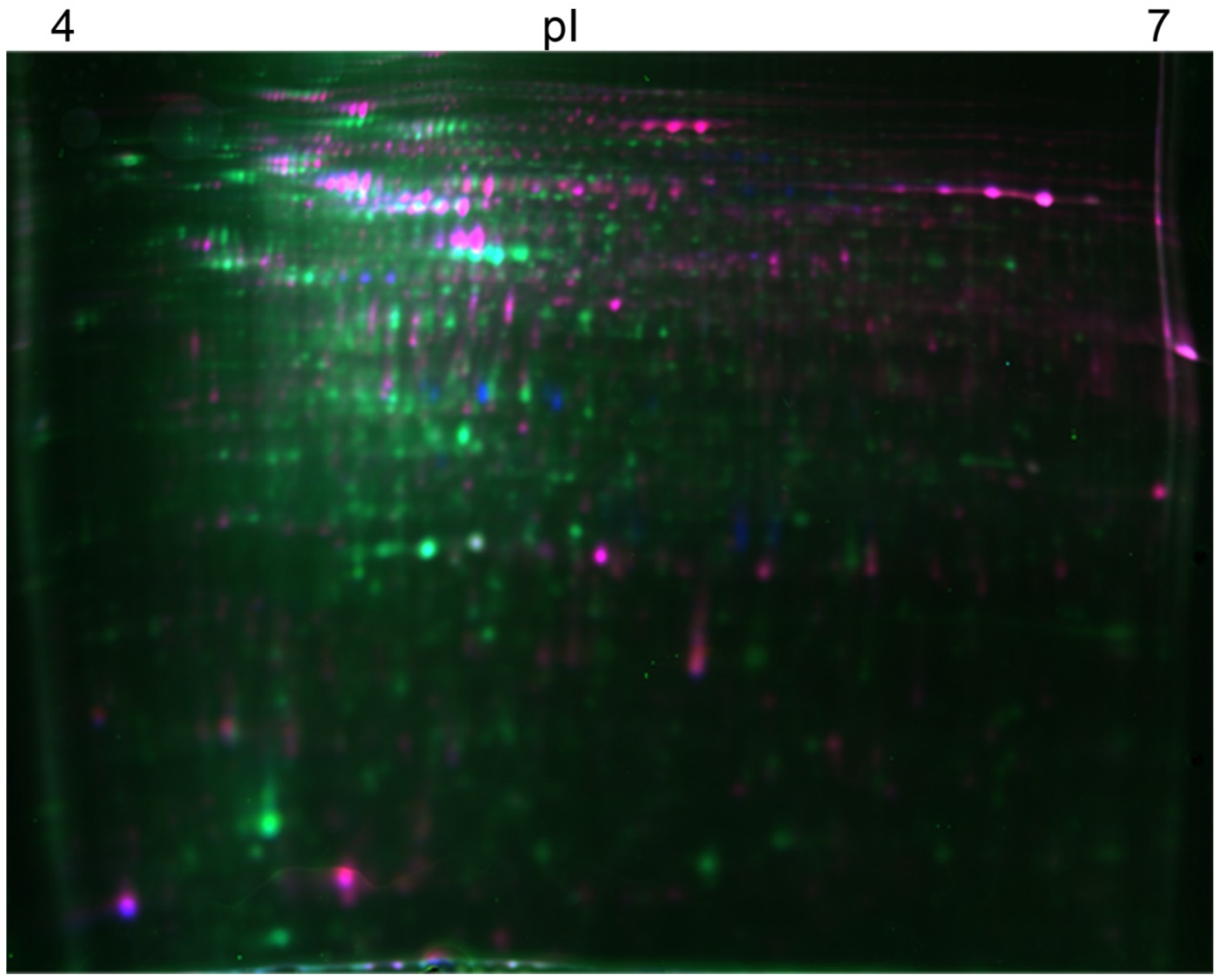
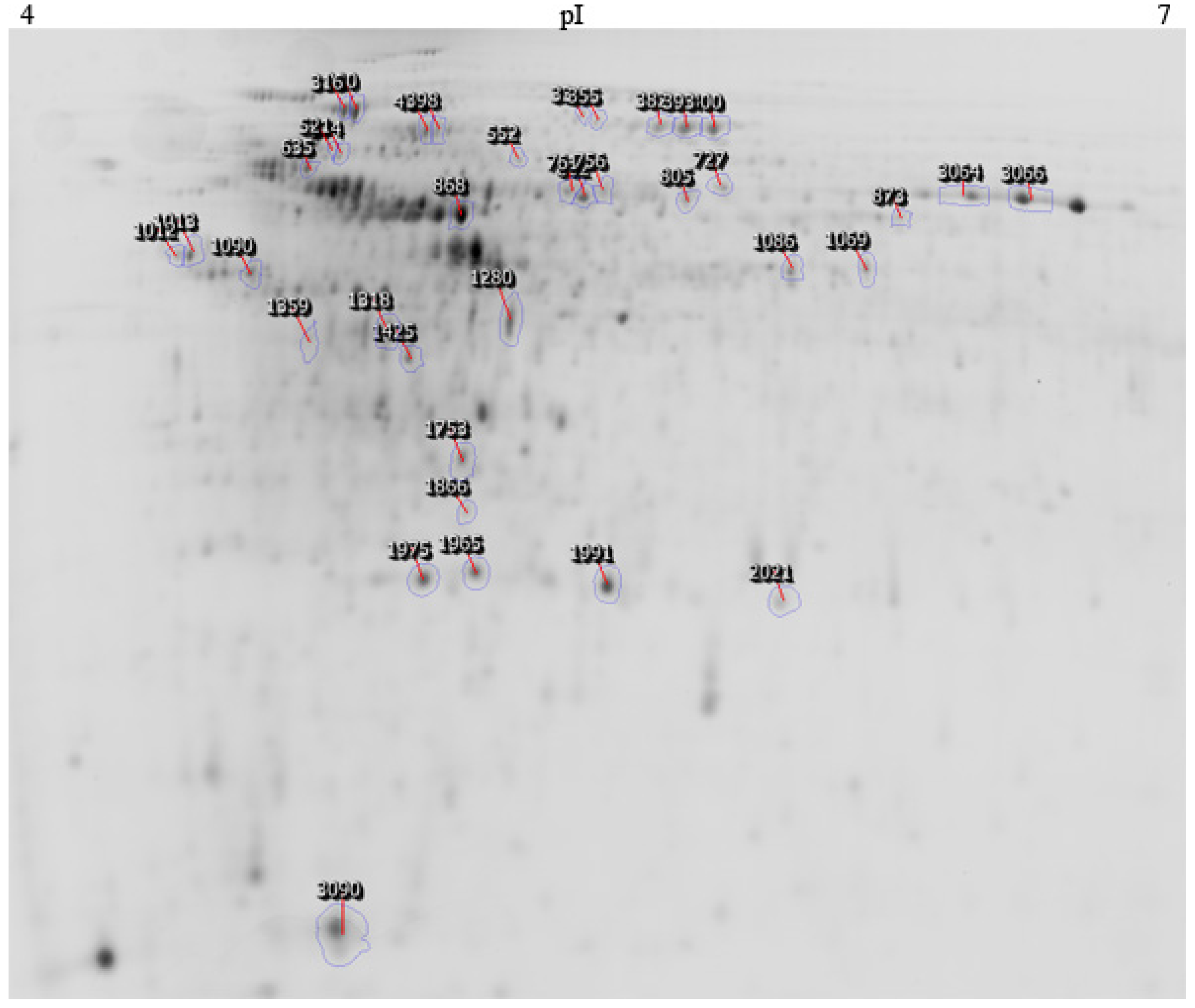
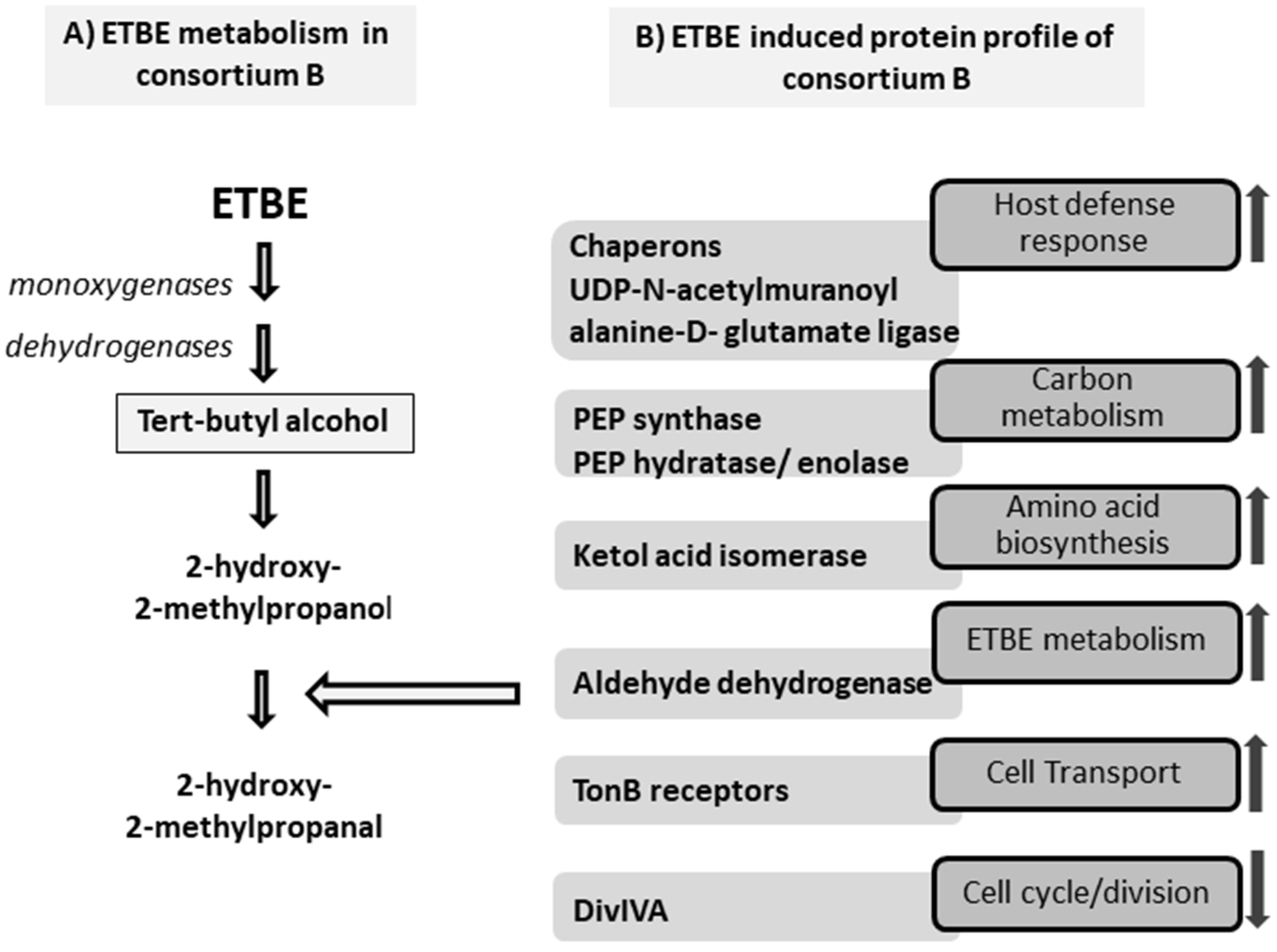
| Gel Number | CyDye | Sample (50 µg) |
|---|---|---|
| 1 | Cy2 | Internal standard |
| Cy3 | BGI | |
| Cy5 | BE500II | |
| 2 | Cy2 | Internal standard |
| Cy3 | BE1000I | |
| Cy5 | BGII | |
| 3 | Cy2 | Internal standard |
| Cy3 | BE500I | |
| Cy5 | BE1000II |
| Colony Name | GenBank Accession Number | Strain (GenBank) a | Strain (RDP) b | Class |
|---|---|---|---|---|
| EB2-1 | KU898255 | Uncultured Xanthomonas sp. | Xanthomonas sp. | γ-proteobacteria |
| EB2-2 | KU898256 | Herbaspirillum sp. MMD15 | Herbaspirillum rubrisubalbicans | β-proteobacteria |
| EB2-4 | KU898257 | Pseudacidovorax sp. ptl-2 | Pseudacidovorax intermedius | β-proteobacteria |
| EB2-7 | KU898258 | Arthrobacter sp. 2073 | Arthrobacter nicotinovorans | Actinobacteria |
| EB2-10 | KU898259 | Pseudacidovorax intermedius | Pseudacidovorax intermedius | β-proteobacteria |
| EB2-11 | KU898260 | Pseudacidovorax intermedius | Pseudacidovorax intermedius | β-proteobacteria |
| EB2-14 | KU898261 | Pseudomonas sp. | Pseudomonas veronii | γ-proteobacteria |
| EB11-1 | KU898262 | Pseudomonas fluorescens hswX151 | Pseudomonas fluorescens | γ-proteobacteria |
| EB11-2 | KU898263 | Xanthomonas sp. FSBSY16 | Xanthomonas sp. CU12 | γ-proteobacteria |
| SPOT ID | Accession Number | Protein identified (Enzyme Code) | MW [kDa] | pI | Species Homology | Fold Change | Upregulation | Biological Function |
|---|---|---|---|---|---|---|---|---|
| 316 | gi|21231605 | Phosphoenolpyruvate synthase a (EC 2.7.9.2) | 86.2 | 5 | Xanthomonas campestris | 5.12 | ETBE 500 ETBE 1000 * | Gluconeogenesis, Carbohydrate biosynthesis |
| B0RSD3_ XANCB | Phosphoenolpyruvate synthase b (EC 2.7.9.2) | 86.2 | 5 | Xanthomonas campestris | ||||
| gi|77165106 | Fumarate hydratase a (EC 4.2.1.2) | 50.6 | 7.1 | Nitrosococcus oceani | Carbohydrate metabolism, TCA cycle | |||
| 320 | gi|84494866 | Nicotine dehydrogenase chain C a (EC 1.5.99.4) | 88.7 | 4.7 | Janibacter sp. | 4 | ETBE 500 ETBE 1000 | Oxidoreductase activity |
| A3THC9_ 9MICO | Nicotine dehydrogenase chain C b (EC 1.5.99.4) | 88.7 | 4.7 | Janibacter sp. | ||||
| 393 | H0BRS3_ 9BURK | Aldehyde oxidase (EC 1.2.3.1) and xanthine dehydrogenase molybdopterin-binding protein b (EC 1.17.1.4) | 85.1 | 5.5 | Acidovorax sp. NO-1 | 10.70 | ETBE 500 ETBE 1000 | Oxidoreductase activity Purine metabolism |
| 400 | gi|84625297 | Putative TonB-dependent receptor a (EC 3.6.3.34) | 84.5 | 5.4 | Xanthomonas oryzae pv. oryzae | 14.89 | ETBE 500 ETBE 1000 | Receptor activity, transporter activity |
| 410 | gi|77166367 | Aldehyde dehydrogenase a (EC 1.2.1.16) | 56.9 | 5.2 | Nitrosococcus oceani | 1.60 | Glucose | Oxidoreductase activity Glycolysis/Gluconeogenesis Microbial metabolism in diverse environments |
| 552 | C0ZVY3_ RHOE4 | Aldehyde dehydrogenase b (EC 1.2.1-) | 55.1 | 4.8 | Rhodococcus erythropolis | 4.20 | ETBE 500 ETBE 1000 * | |
| D0LAD0_ GORB4 | Aldehyde dehydrogenase (NAD(+)) b (EC 1.2.1.3) | 55.3 | 4.9 | Gordonia bronchialis | ||||
| gi|1174662 | EPTC-inducible aldehyde dehydrogenase a (EC 1.2.1.3) | 55 | 4.9 | - | ||||
| 727 | gi|152968176 | Chaperone protein DnaK a | 66.4 | 4.7 | Kineococcss radiotolerans SRS30216 | 4.80 | ETBE 500 ETBE 1000 * | Protein folding, Stress response |
| K1ET82_ 9MICO | Chaperone protein DnaK b | 67.1 | 4.4 | Janibacter hoylei PVAS-1 | ||||
| gi|84497587 | molecular chaperone DnaK a | 67.9 | 4.5 | Janibacter sp. HTCC2649 | ||||
| 1013 | gi|84497843 | Phosphopyruvate hydratase a (EC 4.2.1.11) | 45.9 | 4.4 | Janibacter sp. HTCC2649 | 2.50 | ETBE 500 ETBE 1000 * | Glycolysis/Gluconeogenesis |
| gi|21221535 | Phosphopyruvate hydratase a (EC 4.2.1.11) | 45.5 | 4.3 | Streptomyces coelicolor A3 | ||||
| H0QHC6_ ARTGO | Enolase b (EC:4.2.1.11) | 45 | 4.3 | Arthrobacter globiformis | ||||
| 1086 | I0KWX5_ 9ACTO | Enolase b (EC 4.2.1.11) | 45 | 4.5 | Micromonospora lupini str. Lupac 08 | 7.20 | ETBE 500 ETBE 1000 | Glycolysis/Gluconeogenesis |
| C0FPT6_ 9FIRM | Enolase b (EC:4.2.1.11) | 50.3 | 4.8 | Roseburia inulinivorans DSM 16841 | ||||
| 1280 | gi|121998872 | UDP-N-acetylmuramoylalanine--D-glutamate ligase a (EC 6.3.2.9) | 46.1 | 5.1 | Halorhodospira halophila SL1 | 6.50 | ETBE 500 ETBE 1000 * | Cell wall biogenesis/degradation |
| D0WEA8_ 9ACTN | Glyceraldehyde-3-phosphate dehydrogenase, type I b (EC 1.2.1.12) | 35.8 | 5.2 | Slackia exigua | Glycolysis | |||
| 1425 | H0QLW5_ ARTGO | Ketol-acid reductoisomerase b (EC 1.1.1.86) | 37.2 | 4.7 | Arthrobacter globiformis | 2.45 | ETBE 500 ETBE 1000 | Branched-chain amino acid biosynthesis |
| E3BB64_ 9MICO | Ketol-acid reductoisomerase b (EC 1.1.1.86) | 37.2 | 4.7 | Dermacoccus sp. Ellin185 | ||||
| 1753 | A0JVA2_ ARTS2 | DivIVA family protein b | 25 | 5 | Arthrobacter sp. (strain FB24) | 18.50 | Glucose | Cell cycle Cell division |
Publisher’s Note: MDPI stays neutral with regard to jurisdictional claims in published maps and institutional affiliations. |
© 2022 by the authors. Licensee MDPI, Basel, Switzerland. This article is an open access article distributed under the terms and conditions of the Creative Commons Attribution (CC BY) license (https://creativecommons.org/licenses/by/4.0/).
Share and Cite
Gunasekaran, V.; Canela, N.; Constantí, M. Comparative Proteomic Analysis of an Ethyl Tert-Butyl Ether-Degrading Bacterial Consortium. Microorganisms 2022, 10, 2331. https://doi.org/10.3390/microorganisms10122331
Gunasekaran V, Canela N, Constantí M. Comparative Proteomic Analysis of an Ethyl Tert-Butyl Ether-Degrading Bacterial Consortium. Microorganisms. 2022; 10(12):2331. https://doi.org/10.3390/microorganisms10122331
Chicago/Turabian StyleGunasekaran, Vijayalakshmi, Núria Canela, and Magda Constantí. 2022. "Comparative Proteomic Analysis of an Ethyl Tert-Butyl Ether-Degrading Bacterial Consortium" Microorganisms 10, no. 12: 2331. https://doi.org/10.3390/microorganisms10122331





